All products featured are independently chosen by us. However, SoundGuys may receive a commission on orders placed through its retail links. See our ethics statement.
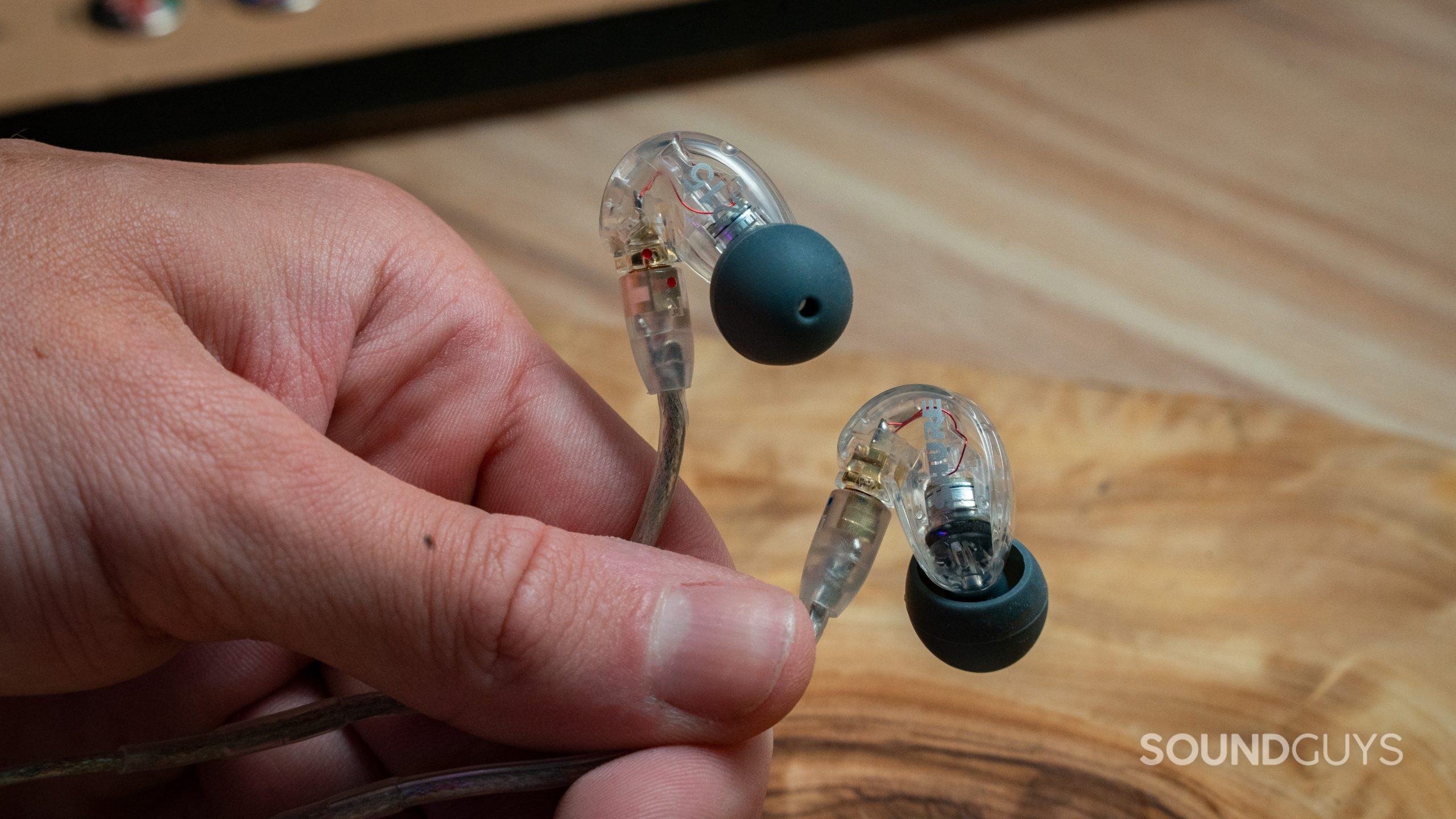

Shure SE215 review
February 25, 2025


Shure SE215
Pretty much everyone could use a set of wired earbuds. They plug into everything your wireless buds can’t connect to, require no batteries, and can outlast Bluetooth buds by years. Turning attention to one of the leading manufacturers of in-ear monitors, Shure, we investigate what $99 gets you. The Shure SE215 is a popular pick at an attractive price with specs that appeal to a cross-section of audio enthusiasts, casual music fans, and musicians.
We put the SE215 through its paces for a week and found out everything you need to know.
- This review was updated on February 25, 2025, in order to update formatting, content.
- This Shure SE215 review was updated on January 5, 2024, to add Multi-Dimensional Audio Quality Scores.
- This review was originally published on September 1, 2022.
Musicians looking for a set of in-ear monitors (IEMs) can appreciate the excellent frequency response and isolation of the SE215. Anyone wanting a solid set of wired earbuds will have very few complaints with the SE215 price to durability and reliability ratio.
What’s it like to use the Shure SE215?
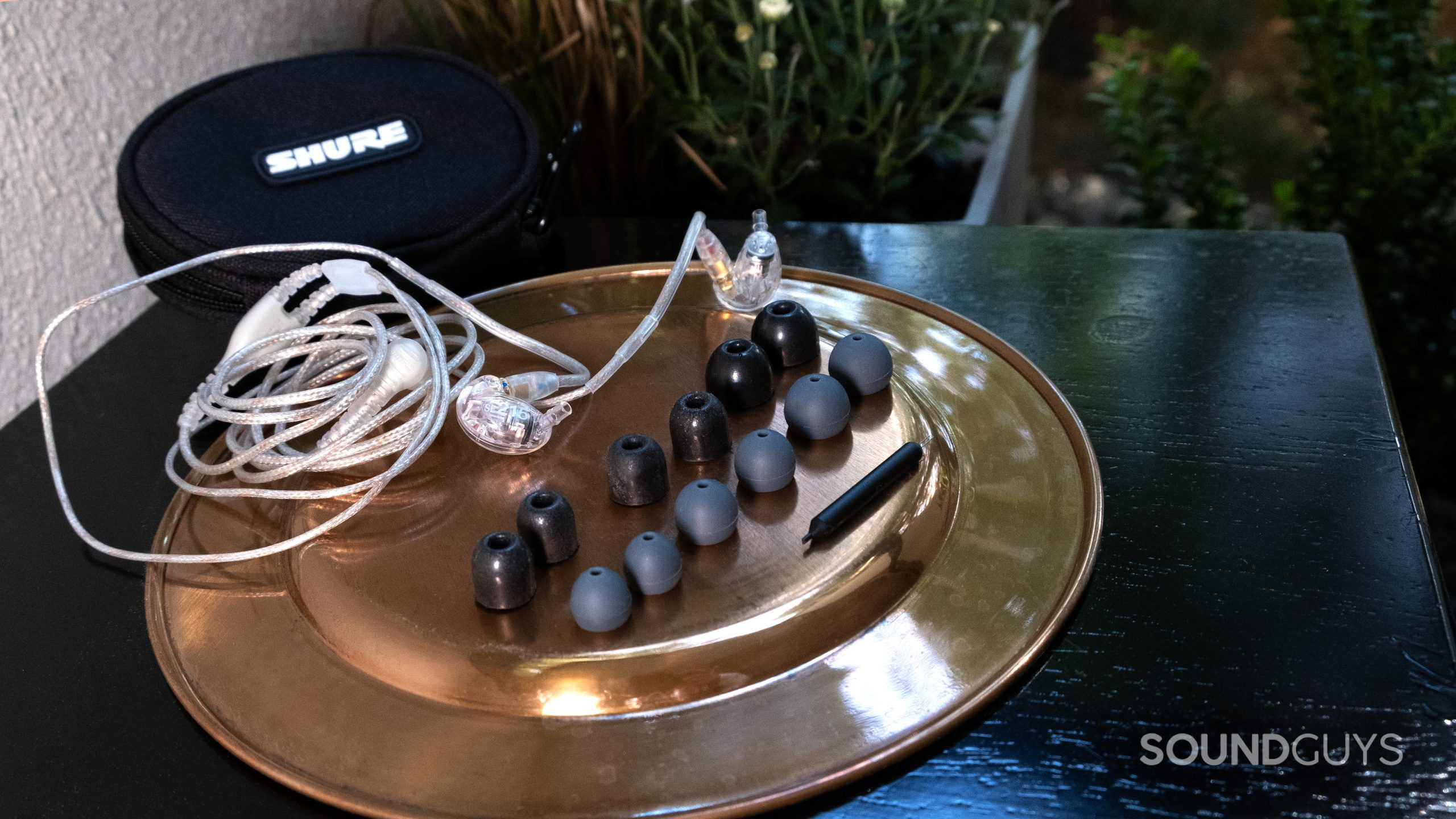
At about $100, the Shure SE215 feels like a complete package. You get three silicone and three memory foam pairs of ear tips. The memory foam pairs measure 12mm, 13mm, and approximately 18mm in diameter. If these sizes sound large, they’re meant to be squished before inserting into your ear canal, where they can expand and create a cogent seal. The silicone ear tip sizes are 11mm, 12mm, and 14mm in diameter, and make it easier to pop the buds in and out. Finally, Shure includes a zippered canvas carry case with an internal pocket for accessories and the supplied cleaning tool.
Initially stiff, the over-the-ear memory wiring molds to your ear shape and becomes fairly comfortable. The quality feels good, and it lacks any irritating seams. The smallest memory foam tip fits my right ear very well, but no matter which size memory foam tip I install on the left bud, the housing protrudes from my ear. Nevertheless, the IEMs feel comfortable for a couple of hours at a time. It doesn’t appear that the robust Kevlar over-ear wiring does much for the actual fit. Instead, it just safeguards the IEMs in case they slide out, or get caught on something and tug.
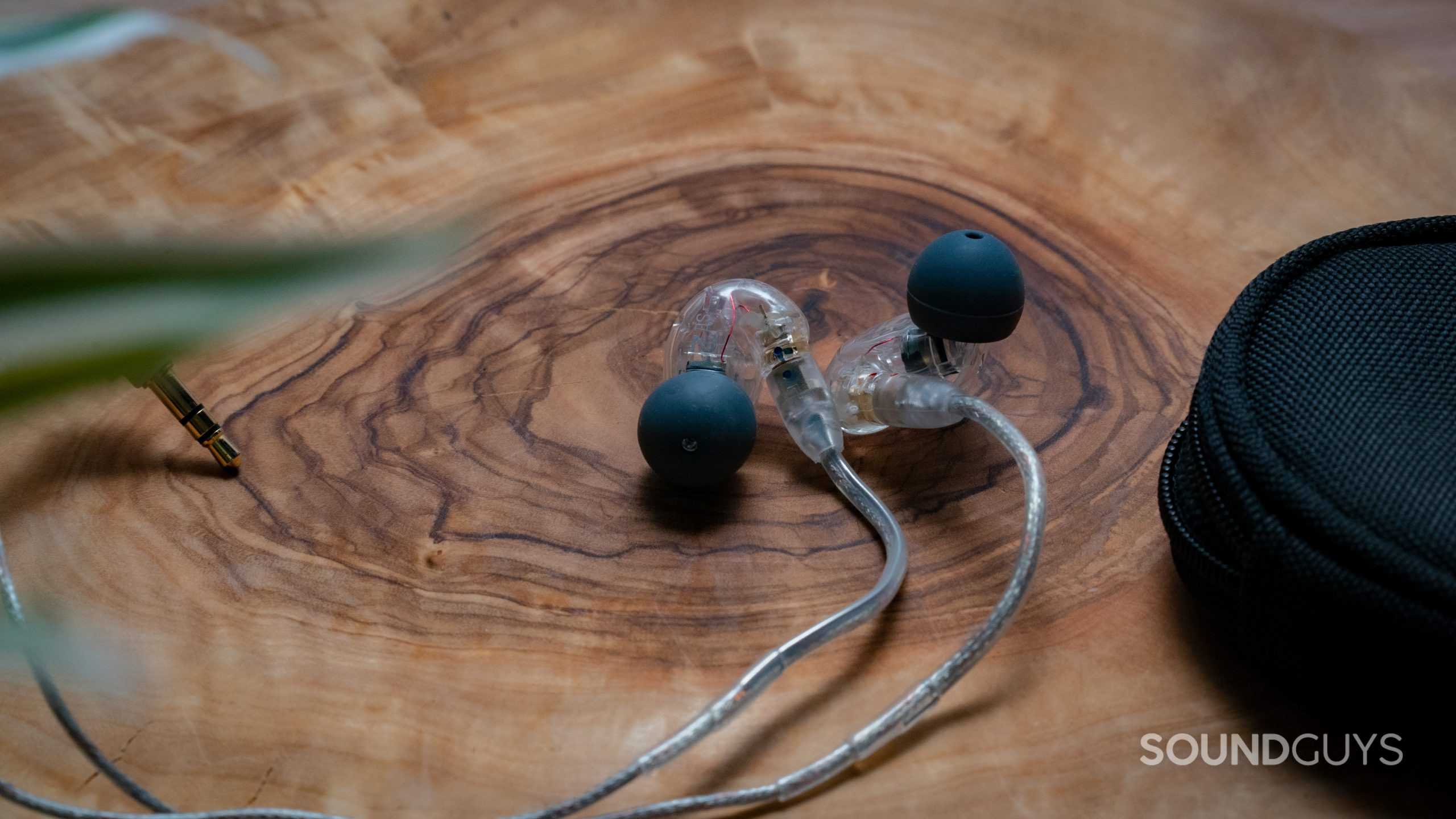
The SE215 comes in clear, black, white, or translucent blue. Occasionally, Shure releases other colorways. Our clear test unit is visually discreet which is great if you want your IEMs to go unnoticed. For the curious, the clear housing is interesting to look at up close, similar to the Nothing Ear 2 but with less of a constructed retro appeal.
The loudness of the drums is still obvious when wearing the SE215 while recording a drummer, but I feel protected from noise-induced hearing loss. Part of that noise reduction speaks to the memory foam ear tips and small nozzle diameter that allows listeners to insert the buds deep into the ear canal. It also helps that you can play audio at lower volumes to make the drums seem that much quieter. Quieting the drums in the room means it competes less with the playback audio. The compact size of the SE215 means you can wear an extra set of over-ear noise protection, too, if you're someone who engineers loud instruments in the same room as you record.
On that note, if you need dedicated hearing protection for live music and events, investing in a pair of purpose built earplugs goes a long way.
How does the Shure SE215 connect?
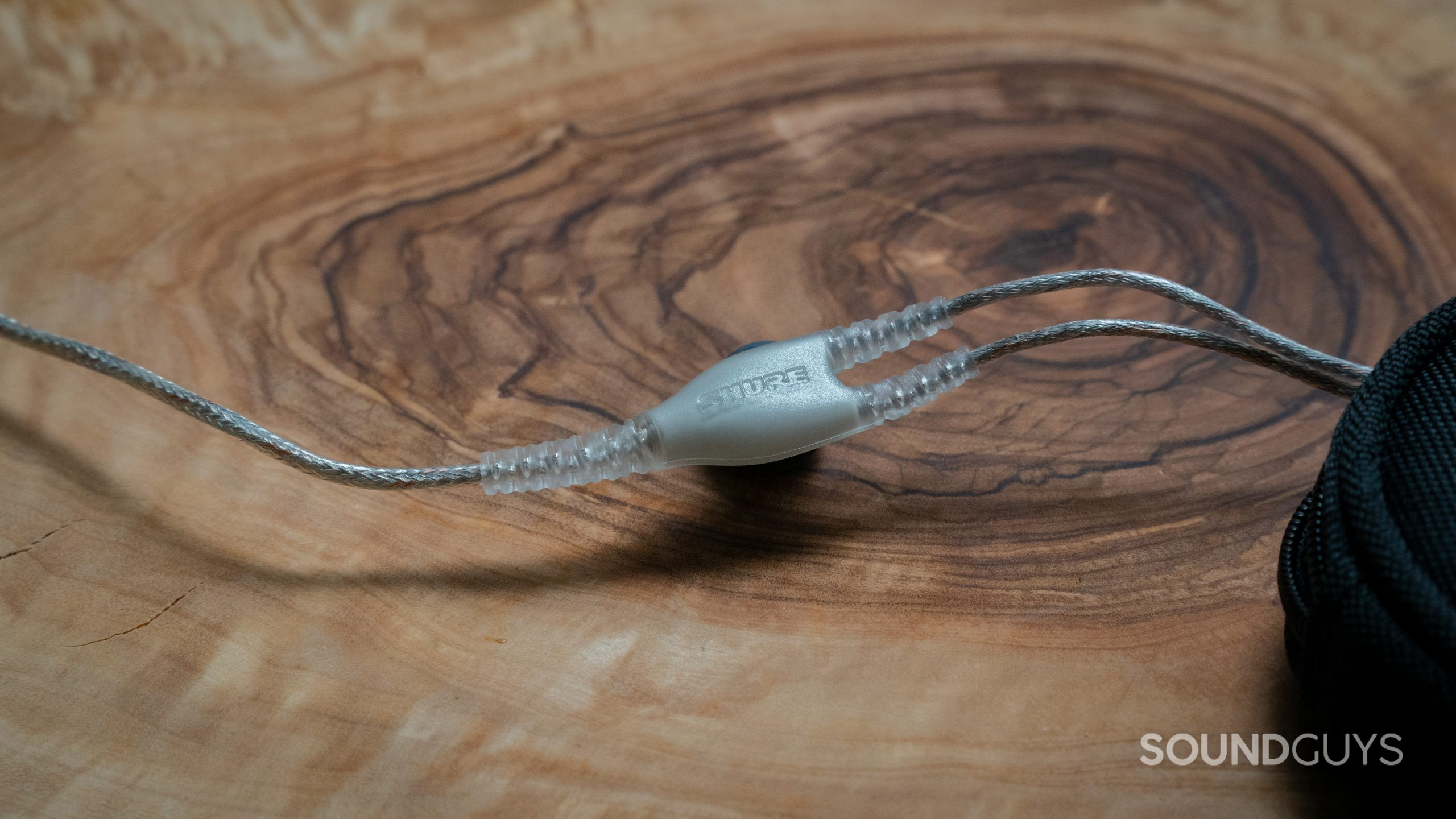
A standard 3.5mm headphone jack is the name of the game with the Shure SE215. This analog connection means you get the best quality audio from your source. You can certainly plug it into your favorite audio player without an external amp or with a digital to analog converter (DAC) dongle if your phone lacks a headphone out. Performers can monitor with the Shure SE215 by plugging it into a radio receiver. This way, you can hear the band or the sound guy, or any number of other applications.
To extend the life of the SE215 you can swap out the cable for another with a compatible MMCX connection. You can also find another version of the SE215 with an in-line remote and mic. You can add wireless capabilities to the SE215 when you purchase the Shure Wireless Adapter (Gen 2) for $189 at Amazon. This works with any MMCX earbuds and supports the aptX, AAC, and SBC Bluetooth codecs, but it will cost you more than the IEMs. At that point, you might as well just purchase the Shure AONIC 215 Gen 2 instead.
The Shure SE215 is very sensitive and gets loud earlier in the volume control range than you might be used to.
At 1kHz it has a sensitivity of 107 dB SPL/mW, with has an impedance of 17Ω. You won't need an amp with this set of IEMs. You'll need a USB-C or Lightning dongle adapter, however, if you plan on using the buds with most phones.
How well does the Shure SE215 block out noise?
Loading chart ...
The Shure SE215 relies on passive isolation to block out background noise, and to get the best isolation, you need to find a proper fit. This test used the size medium memory foam ear tips, and you can probably expect different results with the silicone ear tips. It’s a passive headphone with no active noise canceling (ANC), which you may not really miss if you’re using the SE215. This is some extremely impressive isolation.
The isolation, thanks to the included memory foam ear tips and deep insertion, handily renders 2-10kHz frequencies anywhere from one-sixteenth to one-thirty-second their original perceived loudness. While isolation tends to do its best work on high-frequency noises, the SE215 still halves the loudness of 25-100Hz frequencies. It doesn’t need any batteries, which is just a nice bonus. It also gets a high score from us here.
How does the Shure SE215 sound?
Loading chart ...
As expected with a set of Shure IEMs, the SE215 has a very pleasant frequency response. The sound compares favorably to our headphone preference curve. You should be able to hear everything just fine. The areas where the SE215 deviates most notably are in the highs. The first notable feature is the exaggeration of a narrow band at 5kHz. This may give the impression of greater presence on some instruments, like snares or crash cymbals. Frequencies above that roll off early, from 6kHz up, leading to a sound that focuses more on the fundamentals and lacking some of that full extension of the frequency range. Finally, it under-emphasizes between 2500Hz and just past 4000Hz by 5dB at most, compared to our preference curve.
Listening to the 2020 stereo remaster of This Time Tomorrow by The Kinks during the intro hard stereo panning of the airplane sample moves from the left channel to the right, highlighting the excellent isolation of the SE215. I notice acutely how little I hear in the ear that has no sound coming through. When the music kicks in all the instruments play at reasonable volumes.
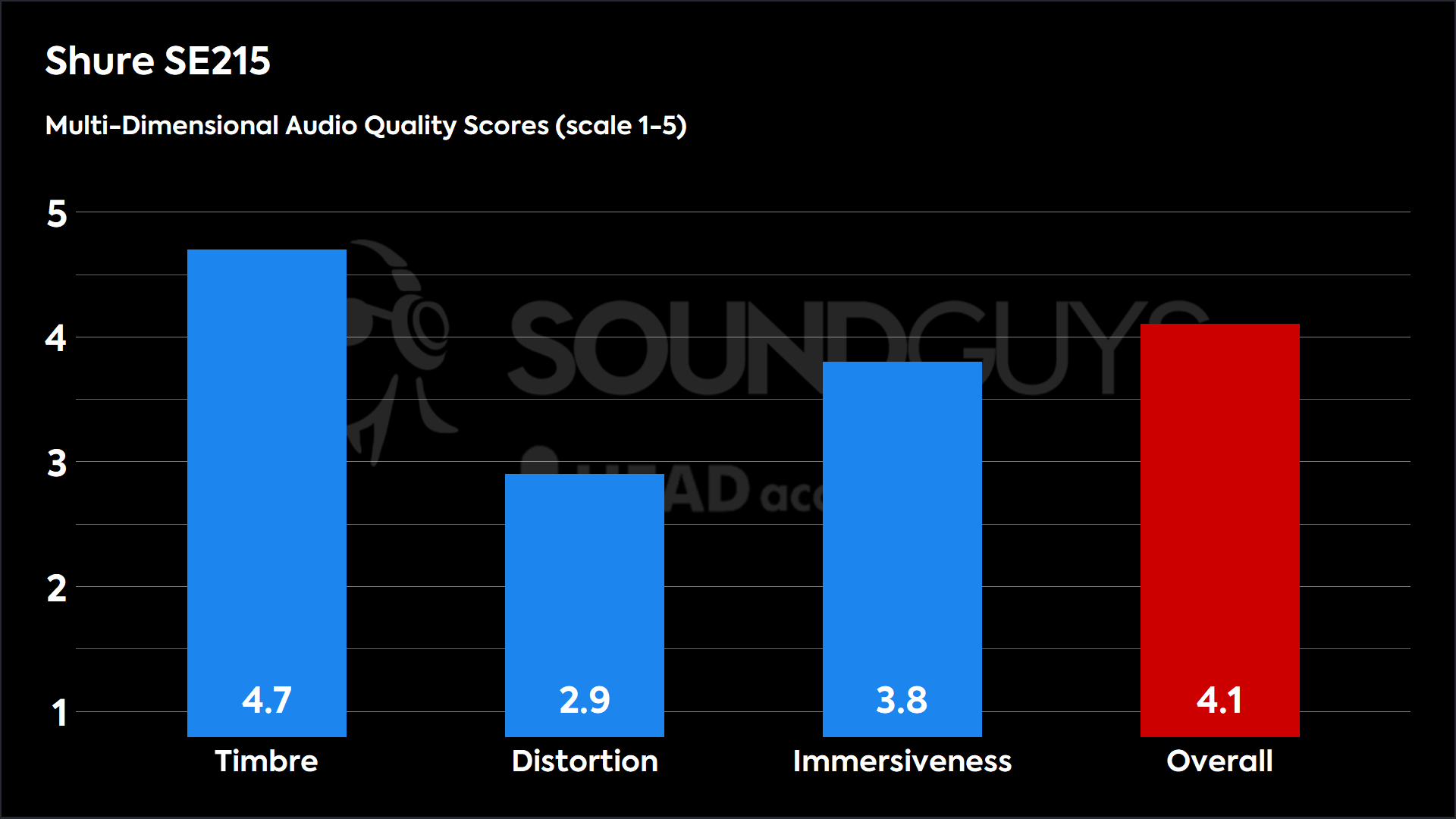
Interestingly, there’s a bit too much low end relative to the under-emphasis in the details of the uppermost frequencies. It gives the impression that some information is too quiet, or missing, and that’s fine for most instruments, but it’s noticeable in the tonality of vocals here. However, it’s impressive that the very busy arrangement of piano, guitars, and organ occupying similar frequencies are all audible simultaneously with the bass and hi-hats. The instrumental portions sound great.

When compared with an older master of the same song that has more emphasis on those high frequencies, I prefer the older version to the remaster with the Shure IEMs. This comes down to the Shure SE215 frequency response rolling off the volume above 6kHz and that under-emphasis around 2500-4000Hz, in concert with the older master having more volume in the highs. Referring to the same tracks on the JBL Club Pro Plus, the details in the uppermost frequencies sound more natural on the 2020 remaster. Meanwhile, those keys and guitars play at better volumes on the SE215 on the remaster.
With music made in more recent decades, like the jangly song, Motion by Days the SE215 sound seems more consistent, due probably to the ubiquity of modern mixing techniques. The clean guitar, percussion, and bass all play at reasonable volumes on the SE215. Vocals can sound a hair muffled without the full upper register extension, but it’s not necessarily distracting. You can always try using an equalizer to boost those frequencies where it dips down at above 6kHz too.
Should you buy the Shure SE215?
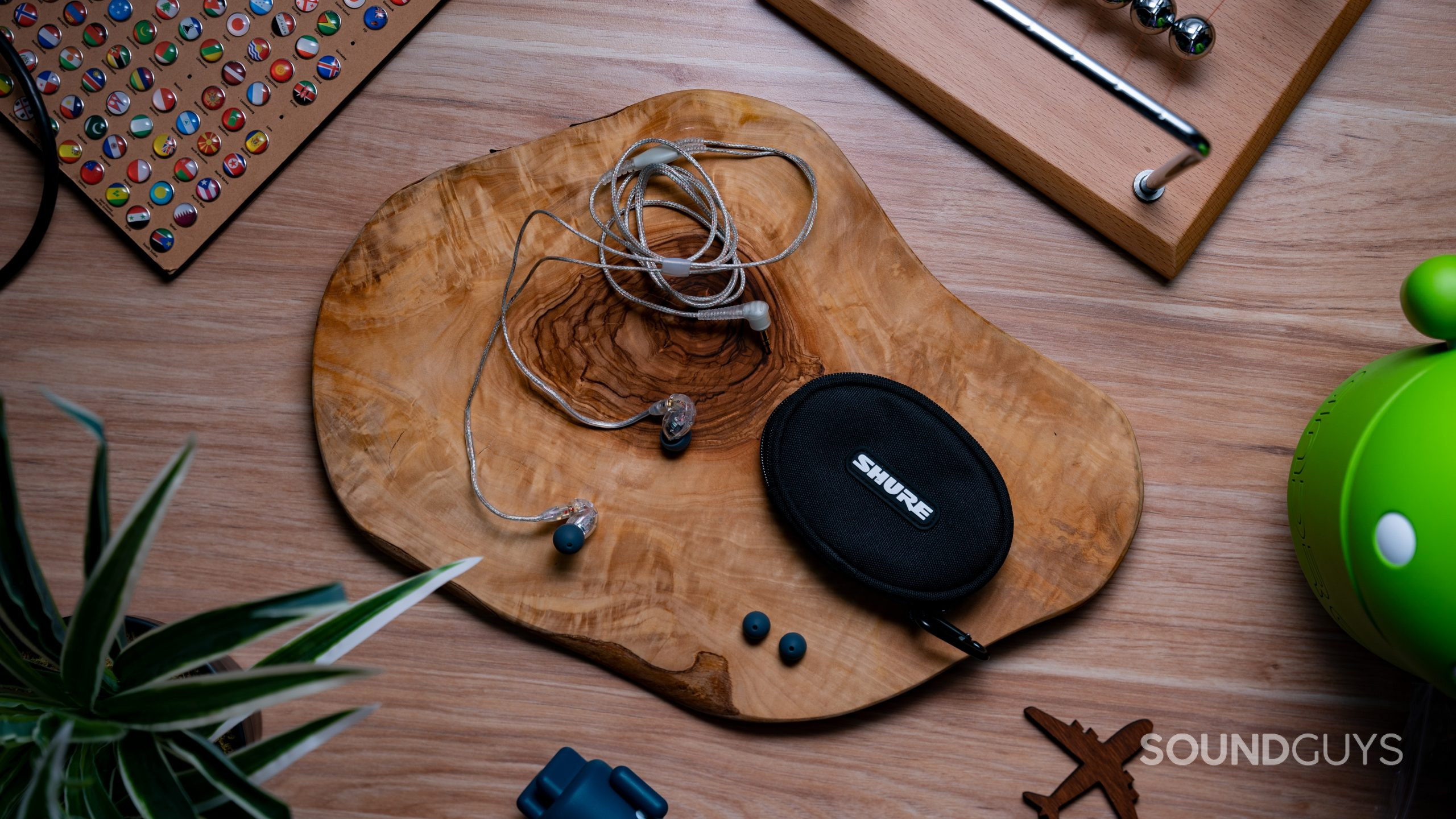
There are plenty of applications the Shure SE215 suits, promoting it as a wise purchase. Wireless earbuds, while convenient at times, do not easily connect to everything. If you need to plug into an electronic instrument, edit video without concerns about latency, sing on a stage, or do a myriad of other tasks, you’ll want wired monitors to truly hear what you’re attending to.
Shure built the SE215 to feel reliable and solid, and it does an excellent job of isolating external noise. While the housing doesn’t necessarily provide a universally secure fit, the shape of the nozzle means the ear tip will fit fine even if the housing doesn’t hug your ear perfectly. Only when you get nitpicky might the quiet uppermost registers of the SE215 frequency response bug some listeners, however, the vast majority of music sounds great on the Shure SE215. Unless you really desire treble articulation, the SE215 satisfies most folks. The price isn’t cheap, but it outperforms some of the more niche “audiophile” buds for less money.


What should you get instead of the Shure SE215
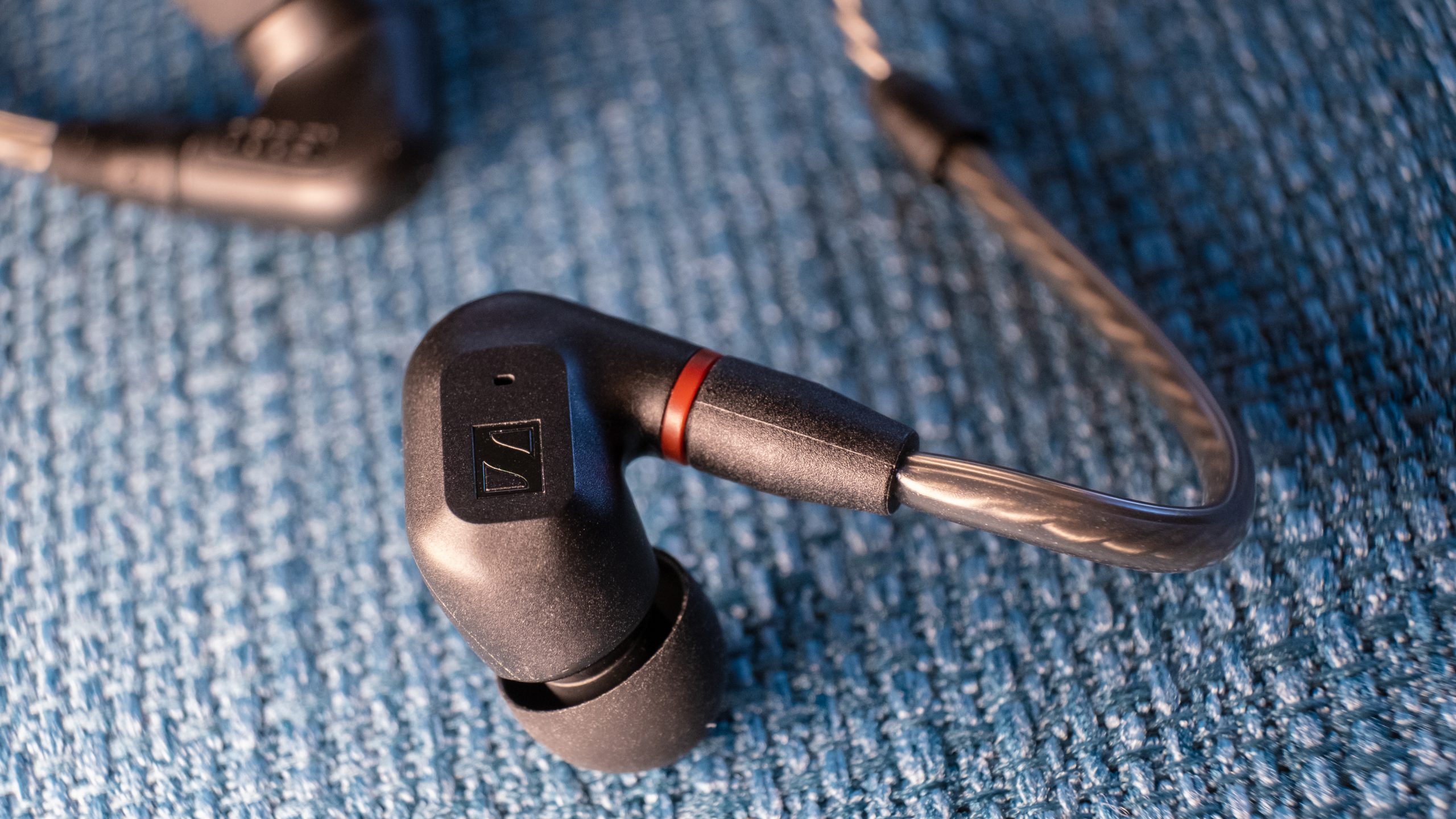
For a more exacting frequency response curve, the Sennheiser IE 200 gets you closer to our preferred tuning. Like the Shure SE215, it’s well made and primarily plastic. The housings measure slightly smaller than the Shure SE215 as well, so if your ears are on the smaller side, it might be a better choice. Utilize the included memory foam ear tips to achieve pretty good isolation. You can pick up a set for $119 at Amazon.
Another interesting choice, the Moondrop Aria, typically sells for less than the SE215 ($79 at Amazon) and performs rather well. Its housings are made of CNC machined metal, so it’s hefty with no rough edges. Like the Shure SE215, the Moondrop Aria’s frequency response mirrors our target curve well with some similar under-emphasis in the upper registers. However, unlike the SE215, it would not make a great set of IEMs in a noisy environment due to its unimpressive isolation performance. If you’re just listening to music, and not actively recording anything that’s less of an issue.
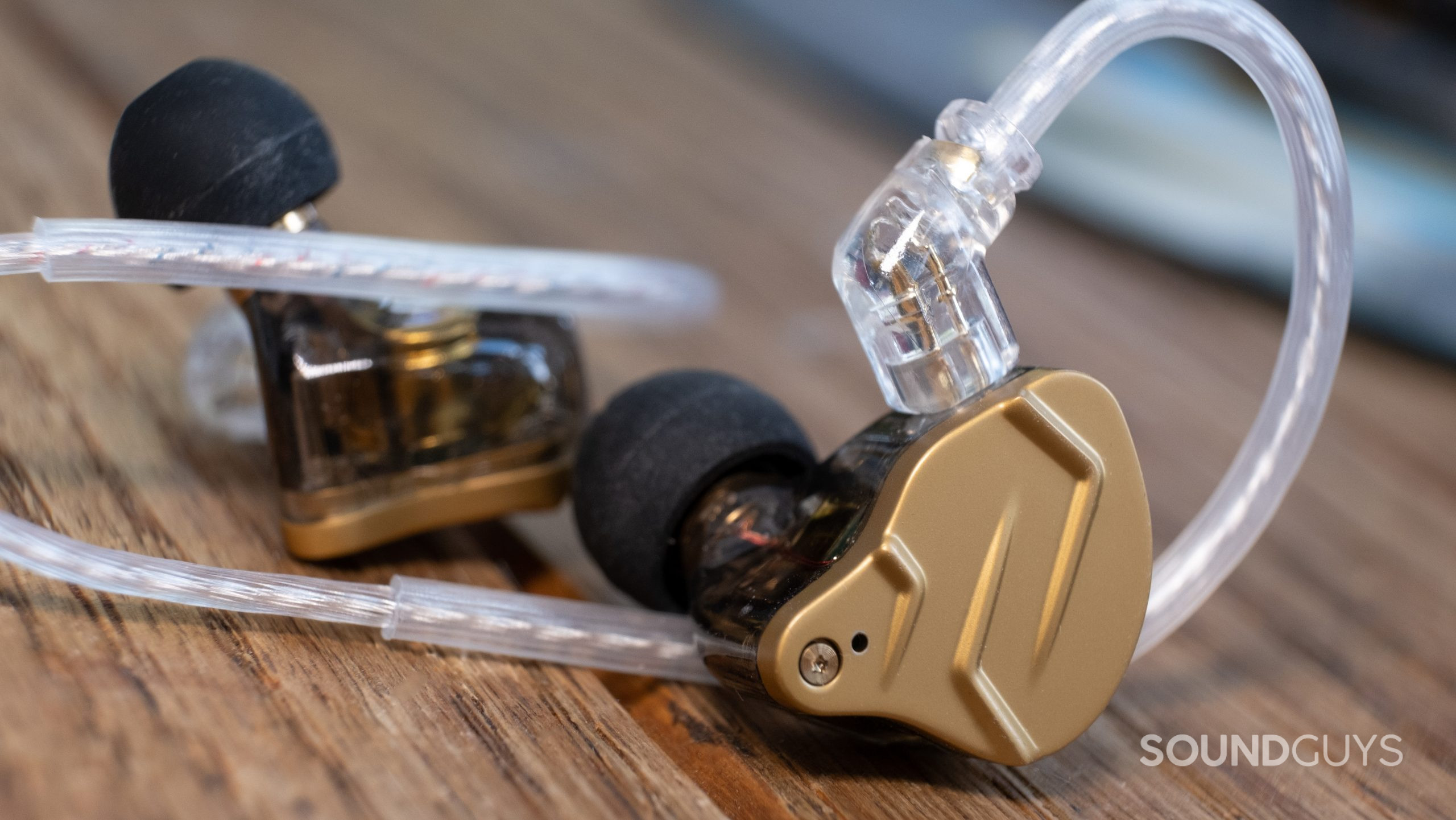
If you want something a bit cheaper, check out the KZ ZSN Pro X for only $23.99 at Amazon. It’s decidedly less upscale than the Shure SE215, but it has a favorable consumer-oriented sound, with a bit of extra treble emphasis absent on the SE215. The build features a mixture of metal and plastic, with over-the-ear cabling. Isolation is not as impressive, but the music listening experience is pretty similar to the SE215.
On the surprisingly cheap and cheerful front, the JBL Quantum 50 is a set of gaming earbuds that follows our target curve extremely well. You can find it for the price of a bag of really nice coffee beans ($34 at Amazon). The build is more plasticky, and the cable is not removable, but it houses a mic/remote module.
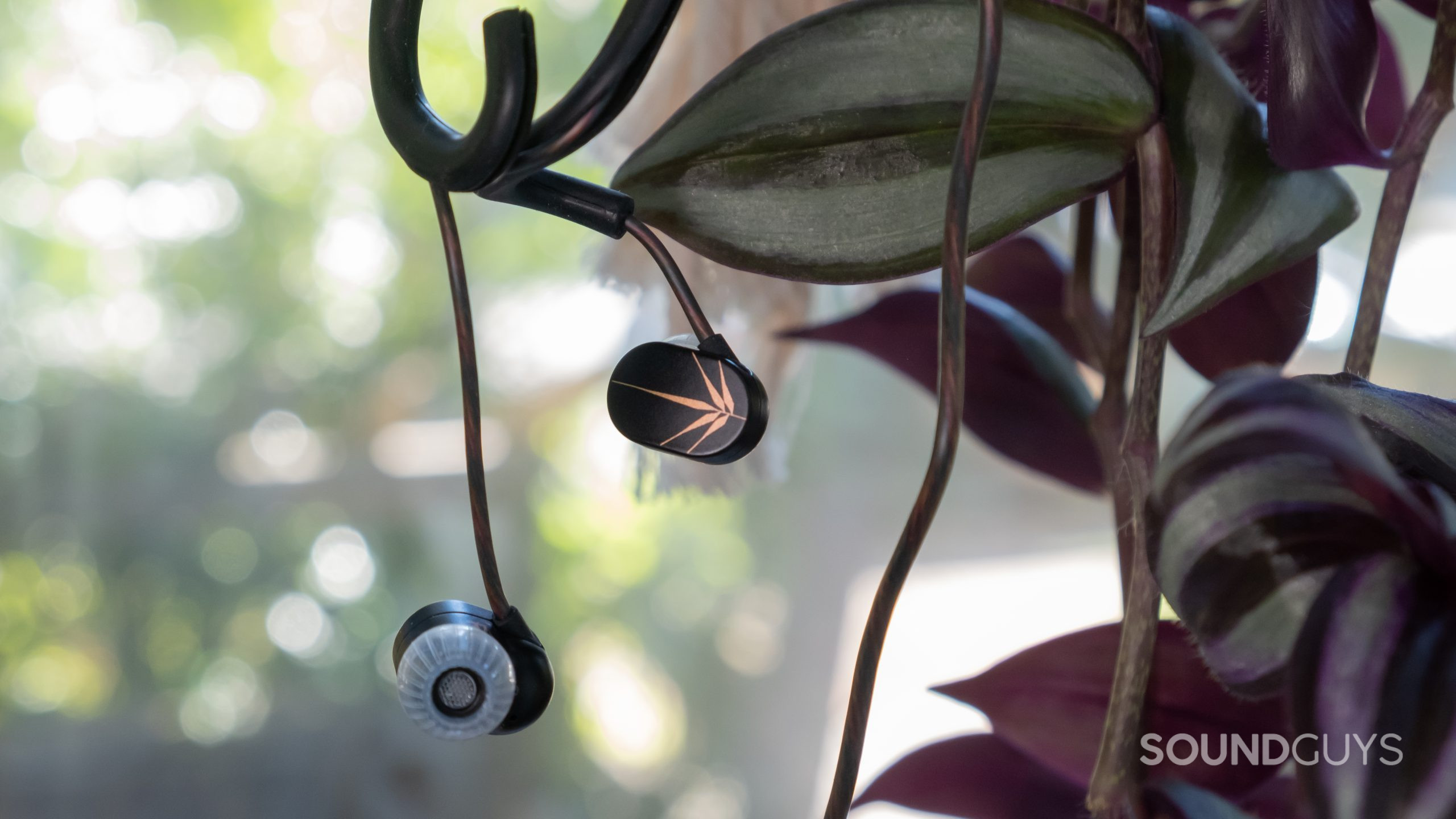
Similarly inexpensive wired earbuds are the Moondrop Chu earbuds ($21 at Amazon). These are made with metal housings and a non-removable cable that wraps over the ear. While imperfect, with a sleeve that covers the cable, they sound very good and come with a remote control.
Wireless Shure alternatives to the Shure SE215
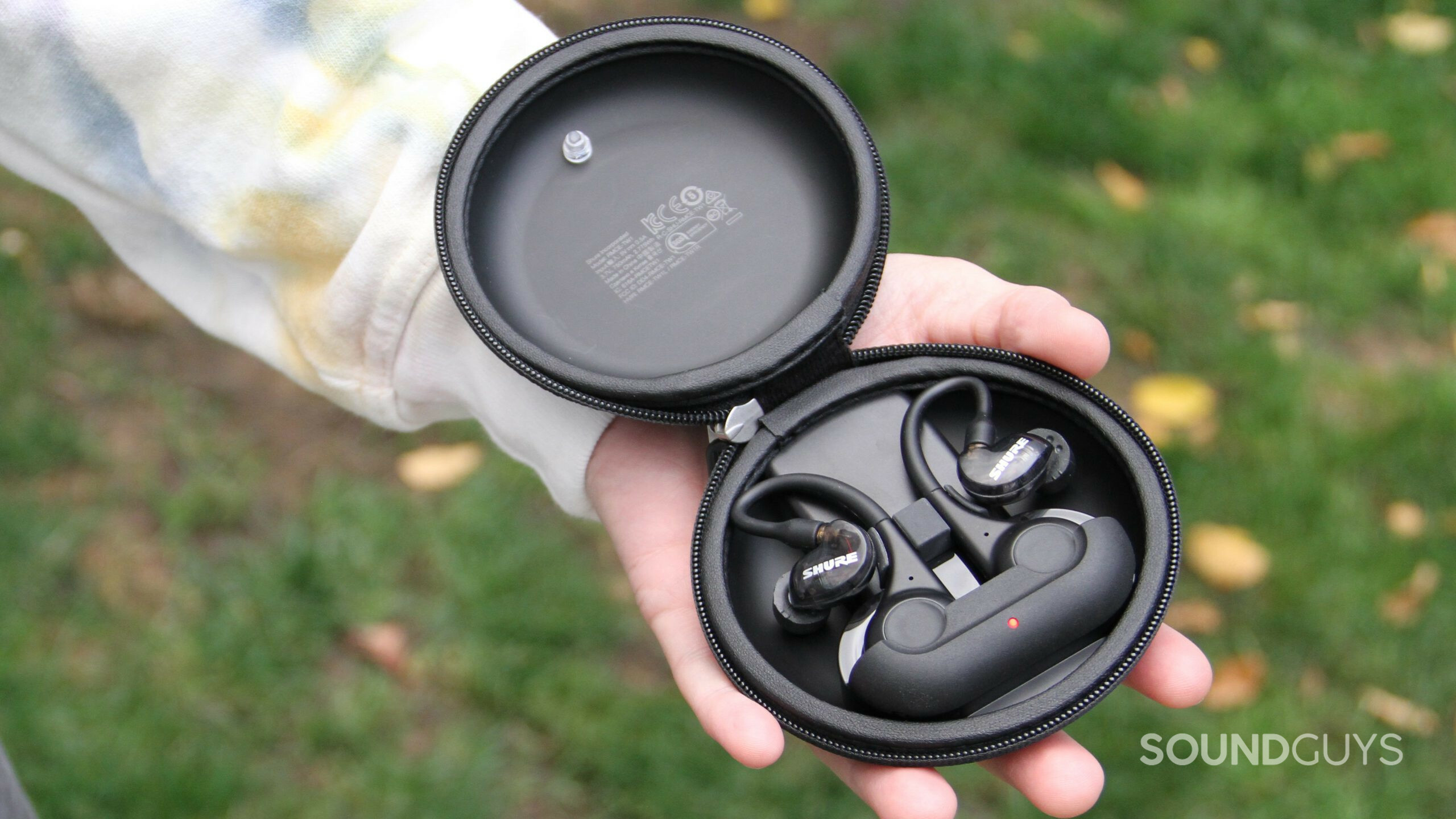
If you like how the Shure SE215 sounds, but would really rather go wireless, consider the Shure AONIC 215 Gen 2. It’s essentially the SE215 but with ear hook Bluetooth modules. The design is not without blunders, particularly the carry case, but a separate MMCX cable can quickly transform this into a wired pair of earbuds, which is a neat trick. Expanding the sound of the SE215 buds, the ShurePlus PLAY app included with the AONIC 215 Gen 2 offers some of the most granular EQ out there in a free app. As a two in one, it’s not bad for $229 at Amazon.
Staunchly in the land of true wireless, the Shure AONIC Free features a similar frequency response, but it’s Bluetooth only. The upshot of this design is that it’s less delicate than the AONIC 215 Gen 2. Like the SE215, it boasts effective isolation. It also has the ShurePlus PLAY app. The AONIC Free is well engineered and sells for $199 at Amazon.
Frequently asked questions
This one is confusing. The Shure SE215 Pro is basically identical to the standard SE215. The difference is in whether you get the audio-only cable, or the cable with a mic and in-line remote. Adding to the confusion is that models listed as the "Pro" version don't actually say so on the box. Technically, our review is of the SE215 Pro because of the cable, but pick up the box and it designates our unit as the SE215-CL (CL for clear), which is exactly what it says on the non-Pro SE215. We like Shure, but the naming schema seems needlessly inconsistent. One wonders if this is just Shure hopping on the train of calling everything "Pro."
Shure has quite a few variations of the SE215, ranging in color schemes to cable configurations. One of these is the Shure SE215 with an in-line mic with a remote. Our test unit is the wired cable version only, so we did not test any microphone. It should have the same functionality as the version we've reviewed here, just with added mic and control.
While it can be fiddly to repair such a small piece of tech in the event life happens and you misplace or break something, you don't have to throw the whole set away. You can readily find new cables, new ear tips, or even individual left and right earbuds. If you need to send in your Shure SE215 for repair, check out this page with details from Shure.
The suite includes a replaceable cable, prolonging the lifespan of the SE215, a case, a sincerely useful selection of ear tips, and a tool for cleaning.
Thank you for being part of our community. Read our Comment Policy before posting.